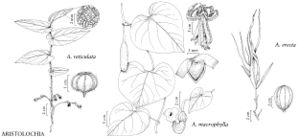Aristolochiaceae
Herbs or lianas [shrubs, rarely trees], deciduous or evergreen, often aromatic. Wood with broad medullary rays. Leaves alternate, simple, petiolate. Leaf-blade unlobed, margins entire. Inflorescences terminal or axillary, racemes or solitary flowers, rarely fan-shaped cymes. Flowers bisexual; calyx enlarged, petaloid, usually tubular, [1-,] 3-, [6-, rarely 5-] merous, lobes valvate; corolla usually reduced to scales or absent; stamens 5, 6, or 12 [multiples of 3 or 5], free or adnate to styles and stigmas, forming gynostemium; anthers extrorse; pistil 1, 4-6-carpellate; ovary inferior, partly inferior, or superior; placentation axile (and ovaries 4-6-locular) or parietal; ovules many per locule, anatropous. Fruits capsules [follicles], regularly to irregularly loculicidal, rarely indehiscent [septicidal]. Seeds often flattened; endosperm copious.
Distribution
Primarily pantropical and subtropical
Discussion
Genera 5, species ca. 600 (3 genera, 28 species in the flora).
Selected References
None.
Lower Taxa
Illustrations
Key
| 1 | Calyx bilaterally symmetric, usually bent or curved; ovary inferior; stems erect, twining, or procumbent. | Aristolochia |
| 1 | Calyx radially symmetric, straight; ovary inferior, partly inferior, or superior; stems rhizomatous. | > 2 |
| 2 | Sepals distinct; anthers each with prominent terminal appendage; styles connate in column; ovary inferior. | Asarum |
| 2 | Sepals connate for most of length; anthers without terminal appendages; styles distinct (except sometimes at extreme base); ovary superior or ca. 1/3-inferior. | Hexastylis |
"broad" is not a number.

